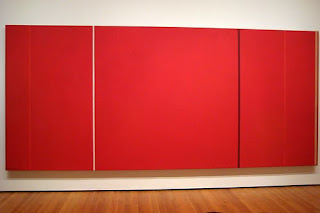
Throughout the 1930’s Barnett Newman did a number of works that could be described as an expressionist style, but he eventually destroyed all of them. His first surviving artwork was made in 1945, three years prior to his first art exhibition. Up until this point Newman had studied Philosophy at the College of New York, and worked as a writer, critic, and exhibition organizer. Throughout the 1940’s Newman worked in a very surrealist style, characterized by multi-tonal vibrant monochromatic color separated by thin vertical lines he called “zips.” The zips are used as devices to divide the color, but rather than divide the canvas into separate large paintings, they actually lend unity and structure to the composition as a whole. Later in his life Newman used hard edged areas of flat color, which can be viewed as a source of inspiration for later minimalist works.
The large size of Newman’s paintings is very indicative of his art philosophy. For Newman, he wanted people to view the art and get a sense of the scale, and to also understand that there is a mystery and a metaphysical fact held within the painting. Newman stated with regards to this concept that he and his colleges “favor the simple expression of the complex thought. We are for the large shape because it has the impact of the unequivocal. We wish to reassert the picture plane. We are for flat forms because they destroy illusion and reveal truth.” He hoped that his paintings would give his viewers the feeling of their own totality, separateness, and individuality, but at the same time express their connection to all others.
"Barnett Newman." Absolute Astronomy. N.p., n.d. Web. 3 Apr 2011.
"Barnett Newman and Frank Stella; Art and the Sublime." The Free Library. N.p., 2008. Web. 3 Apr 2011.
"Chronology of the Artist’s Life." The Barnett Newman Foundation. N.p., 2005. Web. 3 Apr 2011.
No comments:
Post a Comment